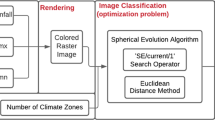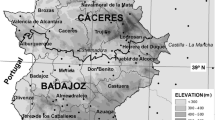Abstract
The division of arid areas is important in water and land resources management, planning and for a long-term agricultural, economic and social planning. Northwest China (NW) dominates the main arid areas in China. There is thus a need to adopt adequate concepts relative to the scope of arid areas of NW China and identify its climate types and characteristics. In this study, we analyzed climatic data over the last 30 years (1981–2010) from 191 stations in three provinces and three autonomous regions of NW China. The factor-cluster analysis technique (FC), an objective and automated method was employed to classify the dry/wet climate zones. The traditional methods with predefined thresholds were adopted for providing a comparison with FC. The results showed that the wet/dry climate zones by FC were mainly distributed along mountains, rivers and desert borders. Climate-division boundaries relied heavily on the major terrain features surrounding the grouped stations. It also showed that the climate was dry in the plain sandy areas but relatively wet in the high mountain areas. FC method can reflect the climate characteristics more fully in NW China with varied and complicated topography, and outperform the traditional climate classifications. Arid areas of NW China were defined as four climate types, including five resultant classes in FC classifications. The Qinling and Da Hinggan Mountains were two important boundaries, besides main administrative boundaries. The results also indicated that there are some differences between two traditional classifications. The precipitation moved and fluctuated to an extent, which confirmed that climate change played an important role in the dry/wet climate zoning, and the boundaries of dry/wet climate zones might change and migrate with time. This paper is expected to provide a more in-depth understanding on the climate characteristics in arid areas of NW China, and then contribute to formulate reasonable water and land management planning and agricultural production programs.
Similar content being viewed by others
References
Abatzoglou J T, Redmond K T, Edwards L M. 2009. Classification of regional climate variability in the state of California. Journal of Applied Meteorology and Climatology, 48(8): 1527–1541.
Ahmed B Y M. 1997. Climatic classification of Saudi Arabia-an application of factor-cluster analysis. Geo Journal, 41(1): 69–84.
Allen R G, Pereira L S, Raes D, et al. 1998. Crop evapotranspiration: guidelines for computing crop water requirements. FAO Irrigation and Drainage Paper 56. Food and Agriculture of the United Nations, Rome.
Arias A C. 1942. The classification of climate. Monthly Weather Review, 70(11): 249–253.
Bernardo S, Soares A A, Mantovani E C. 2006. Irrigation Manual, 6th ed. Viçosa: UFV university press, 625.
Bieniek P A, Bhatt U S, Thoman R L, et al. 2012. Climate divisions for Alaska based on objective methods. Journal of Applied Meteorology and Climatology, 51(7): 1276–1289.
CAS, the Commission for geographical regionalization. 1959. The Climate Gegionalization in China. Beijing: Science Press.
Castillo-Rodríguez M, López-Blanco J, Muñoz-Salinas E. 2010. A geomorphologic GIS-multivariate analysis approach to delineate environmental units, a case study of La Malinche volcano (central México). Applied Geography, 30(4): 629–638.
Chen X J. 1982. A new approach to the climate division of China. Acta Meteorologica Sinica, 40: 35–48.
Dinpashoh Y, Fakheri-Fard A, Moghaddam M, et al. 2004. Selection of variables for the purpose of regionalization of Iran’s precipitation climate using multivariate methods. Journal of Hydrology, 297(1–4): 109–123.
Dregne H, Kassas M, Rozanov B. 1991. A new assessment of the world status of desertification. Desertification Control Bulletin, 6–18.
Fang K Y, Gou X H, Chen F H, et al. 2009. Drought variations in the eastern part of northwest China over the past two centuries: evidence from tree rings. Climate Research, 38: 129–135.
Fovell R G. 1997. Consensus clustering of US temperature and precipitation data. Journal of Climate, 10(6): 1405–1427.
Fu C B, Ma Z G. 2008. Global change and regional aridification. Chinese Journal of Atmospheric Sciences, 32(4): 752–760.
Heim R R. 2002. A review of twentieth-century drought indices used in the United States. Bulletin of the American Meteorological Society: 1149–1165.
Hisdal H, Tallaksen LM. 2003. Estimation of regional meteorological and hydrological drought characteristics: a case study for Denmark. Journal of Hydrology, 281(3): 230–247.
Huang B W. 1959. Draft of overall natural regionalization of China. Chinese Science Bulletin, 18: 594–602.
Kaiser H F, Rice J. 1974. Little Jiffy Mark. Educational and Psychological Measurement, 34: 111–117.
Kim J O, Mueller C W. 1978. Factor Analysis: Statistical Methods and Practical Issues. Sage: Sage University Paper Series in Quantitative Applications in the Social Sciences.
Kostopoulou E, Jones P D. 2007. Comprehensive analysis of the climate variability in the eastern Mediterranean. Part I: map-pattern classification. International Journal of Climatology, 27(9): 1189–1214.
Jacobeit J. 2010. Classifications in climate research. Physics and Chemistry of the Earth, Parts A/B/C, 35(9–12): 411–421.
Li S K. 1987. Agro-climatic regionalization of China. Journal of Nature Resources, 2: 71–83.
Li X Z, Liu X D, Ma Z G. 2004. Analysis on the drought characteristics in the main arid regions in the world since recent hundred-odd years. Arid Zone Research, 23(1): 45–54.
Liu J H, Gao J X, Lv S H, et al. 2011. Shifting farming-pastoral ecotone in China under climate and land use changes. Journal of Arid Environments, 75(3): 298–308.
Liu J G, Diamond J. 2005. China’s environment in a globalizing world. Nature, 435: 1179–1186.
Logan K E, Brunsell N A, Jones A R, et al. 2010. Assessing spatio-temporal variability of drought in the U.S. central plains. Journal of Arid Environments, 74(2): 247–255.
Luo K F. 1954. Draft of natural geography regionalization of China. Acta Geographica Sinica, 20: 379–394.
Malekinezhad H, Nachtnebel H P, Klik A. 2011. Comparing the index-flood and multiple-regression methods using L-moments. Physics and Chemistry of the Earth, Parts A/B/C 36(1–4): 54–60.
Mishra A K, Singh V P. 2010. A review of drought concepts. Journal of Hydrology, 391(1–2): 202–216.
Modarres R, Sarhadi A. 2011. Statistically-based regionalization of rainfall climates of Iran. Global and Planetary Change, 75(1–2): 67–75.
Overall J E, Klett C J. 1972. Applied Multivariate Analysis. McGraw-Hill: New York.
Paulo A A, Pereira L S. 2006. Drought concepts and characterization. Water International, 31(1): 37–49.
Qian W H, Lin X. 2005. Regional trends in recent precipitation indices in China. Meteorology and Atmospheric Physics, 90(3–4): 193–207.
Qian W H, Qin A. 2007. Precipitation division and climate shift in China from 1960 to 2000. Theoretical and Applied Climatology, 93(1–2): 1–17.
Ren M E, Yang R Z. 1961. Issues on physical regionalization in China. Acta Geographica Sinica, 27: 66–74.
Sahin S, Cigizoglu H K. 2012. The sub-climate regions and the sub-precipitation regime regions in Turkey. Journal of Hydrology, 180–189.
Shi Y F, Shen Y P, Kang E S, et al. 2006. Recent and Future Climate Change in Northwest China. Climatic Change, 80(3–4): 379–393.
Sun H G, Yu X. 2012. A research of regional difference in R&D activities in Guangdong, PR China. Progress in Applied Mathematics, 3(1): 22–27.
Um M J, Yun H, Jeong C, et al. 2011. Factor analysis and multiple regression between topography and precipitation on Jeju Island, Korea. Journal of Hydrology, 410(3–4): 189–203.
Unal Y, Kindap T, Karaca M. 2003. Redefining the climate zones of Turkey using cluster analysis. International Journal of Climatology, 23(9): 1045–1055.
UNCCD, United Nations Convention to Combat Desertification. 1994. Elaboration of an International Convention to Combat Desertification in Countries Experiencing Serious Drought and/or Desertification, Particularly in Africa. New York: UNCCD. [1997-2-11]. http://www.un.org.
UNEP. 1992. World Atlas of Desertification. London: Edward Arnold, 69.
Wang G, Cheng G. 2000. The characteristics of water resources and the changes of the hydrological process and environment in the arid zone of northwest China. Environmental Geology, 39(7): 783–790.
Wang L, Xie X Q, Li Y S, et al. 2004. Changes of humid index and borderline of wet and dry climate zone in northern China over the past 40 years. Geographical Research, 23: 45–54.
Wu S H, Yang Q Y, Zheng D. 2002. An index system for boundaries of eco-geographical regions of China. Progress in Geograpgy, 21: 302–310.
Xi C F, Qiu B J, Zhang J M, et al. 1984. Principles and system of physical regionalization. In: the National Commission for Agricultural Regionalization. Outline of Physical Regionalization of China. Beijing: Science Press.
Yang G Y, Wang L, Wang H. 2010. Thinking of food security in China based on regional water resources and land cultivation. Transactions of the CSAE, 26(12): 1–5.
Yang Y Z, Feng Z M, Huang H Q, et al. 2008. Climate-induced changes in crop water balance during 1960–2001 in Northwest China. Agriculture, Ecosystems & Environment, 127(1–2): 107–118.
Zhang B K, Duan Y W, Cao L. 1956. Draft of climate regionalization in China. In: Draft of Physical Regionalization in China. Beijing: Science Press.
Zhang D, Fengquan L, Jianmin B. 2000. Eco-environmental effects of the Qinghai-Tibet Plateau uplift during the Quaternary in China. Environmental Geology, 39(12): 1352–1358.
Zhang G L, Dong J W, Xiao X M, et al. 2012. Effectiveness of ecological restoration projects in Horqin Sandy Land, China based on SPOT-VGT NDVI data. Ecological Engineering, 38(1): 20–29.
Zhang J M. 2006. Study on temporal and spatial distribution of climate resource in Yili River Basin. Arid Meteorology, 24(2): 1–4.
Zhang J T, Li Z. 1999. A Study on demarcation indexes between sub humid and semiarid sectors in China. Progress in Geograpgy, 18: 230–237.
Zhang L Y, Su G W. 1993. Geneses, characteristics and environmental optimization of Northwest China’s arid area. Journal of Arid Land Resources and Environment, 7(3–4): 1–10.
Zhang Q F, Wu F Q, Wang L. 2011. Application of PCA integrated with CA and GIS in eco-economic regionalization of Chinese Loess Plateau. Ecological Economics, 70(6): 1051–1056.
Zhao S Q. 1983. A new scheme for comprehensive geographical regionalization in China. Acta Geographica Sinica, 38: 1–10.
Zhao X, Tan K, Zhao S, et al. 2011. Changing climate affects vegetation growth in the arid region of the northwestern China. Journal of Arid Environments, 75(10): 946–952.
Zheng J Y, Yin Y H, Li B Y, et al. 2010. A new scheme for climate regionalization in China. Acta Geographica Sinica, 65: 3–13.
Author information
Authors and Affiliations
Corresponding author
Rights and permissions
About this article
Cite this article
Geng, Q., Wu, P., Zhang, Q. et al. Dry/wet climate zoning and delimitation of arid areas of Northwest China based on a data-driven fashion. J. Arid Land 6, 287–299 (2014). https://doi.org/10.1007/s40333-013-0206-7
Received:
Revised:
Accepted:
Published:
Issue Date:
DOI: https://doi.org/10.1007/s40333-013-0206-7




